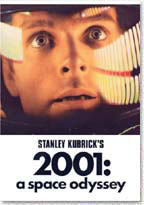 2001 is a story of the evolution of man kind. Humanity finds a mysterious, obviously artificial, object buried beneath the Lunar surface and, with the intelligent computer H.A.L. 9000, sets off on a quest. The sci-fi masterpiece from acclaimed producer Stanley Kubrick about a space voyage to Jupiter that turns chaotic when a computerenhanced with artificial intelligence takes over.
2001 is a story of the evolution of man kind. Humanity finds a mysterious, obviously artificial, object buried beneath the Lunar surface and, with the intelligent computer H.A.L. 9000, sets off on a quest. The sci-fi masterpiece from acclaimed producer Stanley Kubrick about a space voyage to Jupiter that turns chaotic when a computerenhanced with artificial intelligence takes over.
Sometime in the distant past, someone or something nudged evolution by placing a monolith on Earth. Evolution then enabled humankind to reach the moon’s surface, where yet another monolith is found, one that signals the monolith placers that humankind has evolved that far. Now a race begins between computers (HAL) and human (Keir Dullea) to reach the monolith placers. The presumption is that the winner will achieve the next step in evolution.
Two mysteries keep a lot of folks from making sense of this movie: 1). What is the nature of the monolith? What, finally, does it do, or portend, or symbolize? 2). What, specifically, causes HAL to behave in such apparently irrational and pointlessly destructive ways aboard Discovery One?
If you can’t answer these questions, then “2001,” as beautiful as it is to look at, will leave you scratching your head. Well, with deep respect toward all who admire this wonderful movie, and with awareness that these issues have, in part, been successfully addressed by other Amazon reviewers, I’d like to elaborate on these two questions.
First, the monolith. As most Amazon reviewers understand, the extra-terrestrial monolith serves to help life evolve. This isn’t explained by anyone in the movie, but it is clearly demonstrated. In “The Dawn Of Man” segment, the ape touches the monolith and experiences a cognitive “leap forward” when he suddenly understands the advantages of tools for survival. The scientists who find the moon-based monolith never know about the ape’s original exposure on Earth. They can’t put their discovery in context, and, proceeding from this nearly complete ignorance, they send an exploratory spaceship to follow the monolith’s radio signal to Jupiter.
Because additional monoliths appear in more visually fabulous settings toward the film’s end, some viewers believe the monolith’s function becomes ambiguous or even deliberately impossible to understand. But there is no real need to reach for heavy symbolism. The movie makes the most sense when the monolith’s role stays the same: it facilitates evolution wherever it appears.
Director: Stanley Kubrick
Year of Release: 1968
![]()
Character to watch: Keir Dullea as Dr. Dave Bowman.
Journal your answers to the following questions after you watch the movie.
- How does this particular character’s journey compare with yours?
- Did the character develop certain characteristics during the movie that you have or that you would like to have? If so, what are those characteristics?
- What obstacles did this character face? What was his or her biggest challenge?
- What would you have done differently if you had been in the same position as the character?
- Is this character the type of person you would be friends with? Why or why not?